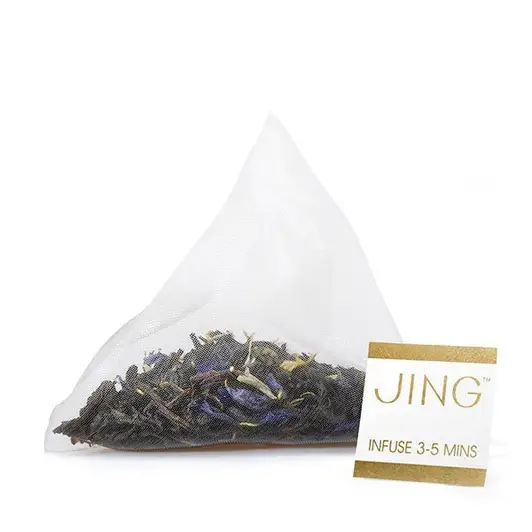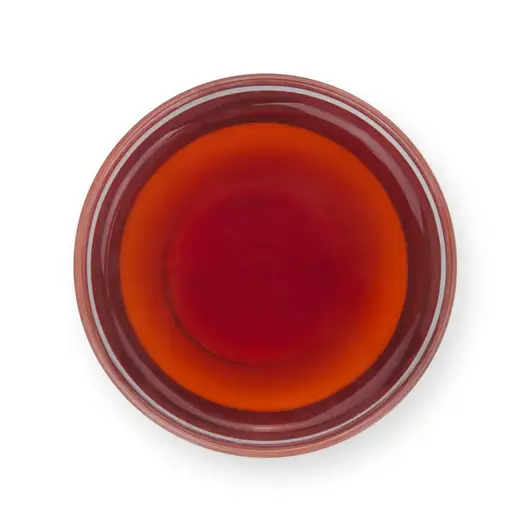
Making sure you use plastic free teabags is important, not only for your health but also for the environment.

Plastic free tea bags are so much better than their paper or plastic counterparts and mean that you won't ingest billions of microplastics with each cup of tea.

Tea bags made from PLA or Soilon will fully biodegrade and should be disposed of in your council food waste bin.

Many supermarket tea bags contain hidden plastics like polypropylene, which means they will take years to break down.

Loose tea will always be the most sustainable way to drink tea, plus there are loads of other benefits. Check out our loose tea guide to find out what they are
While the distinctive tastes of our single garden teas are almost always best enjoyed when the tea is made loose, there are a few occasions when only a teabag will do. For most of us, this is typically when we’re away from home or need to make tea on the go. If you speak to any member of the JING team, you’ll find that many of them pack a selection of JING teabags in their suitcases when they go on holiday – and even day to day in their bags. We often advocate grabbing a few teabags for any long journeys, and for times when finding hot water is easy, but finding good tea is much more challenging! Making sure we always use plastic free teabags though goes without saying, so we can protect our health and the environment.
We’re getting more and more questions about teabags and plastics, so here’s our guide to what teabags are made from, how you can find plastic free tea bags, and why they are so much better than their paper or plastic counterparts.
What are teabags made from?
Teabags can be made from several different materials – you’ll find paper teabags, cotton teabags, food-grade plastic teabags, and even occasionally teabags made from a silk.
Hidden plastics in paper teabags
Did you know, many paper teabags contain hidden plastics? To seal the teabags and to stop the paper disintegrating in your cup, protective glues are used in the manufacturing of these types of bags. Usually, these glues are made from polypropylene, which is an oil-based plastic (this simply means it has been made using fossil fuels). If you’ve ever tried composting a paper teabag which has polypropylene in it, you’ll have seen that even after months and even years, a sort of web is left behind in the compost, which is the plastic remnants.
In recent months, some teabag manufacturers have responded to the global war on plastics and the demand from tea drinkers who do not want to be ingesting billions of microplastics with their tea and switched the oil-based polypropylene for a plant derived PLA glue.
Another style of paper teabag uses a cotton stitch by way of sealing, which makes them naturally plastic free tea bags. So, to summarise, make sure you check the label when buying paper tea bags as some will have plastic in which won’t biodegrade and will leach microplastics into your cup. Others will contain PLA or be stitched with cotton, both which will biodegrade.
What is Soilon or PLA and is it plastic free?
Teabags, including JING’s, can also be made from a biodegradable polymer derived from corn starch, called PLA or Soilon. Teabags made of PLA are heat sealed and so no glue is needed. PLA is a bio-based polymer, which are sometimes known as bioplastics. This term is confusing, especially when we’re also saying PLA is plastic free, so let’s try and explain – and through this, hopefully answer the question of why plastic free teabags are better!

Our tea bags are made from a polymer derived from corn starch called PLA or Soilon, which is fully biodegradable.
What does bioplastic mean?
Simply put, bioplastic means the material does not come from a fossil-based source and will therefore biodegrade. This is not the same as what we commonly think of when we think of plastic. The plastic that is commonly considered is made from oil derived from fossil fuels, known as petro-based polymers. These petro-based polymers are not only made from non-renewable sources, but they are made in such a way that they never completely breakdown – and even take hundreds of years to degrade at all.
Bioplastics or bio-based polymers are made from renewable biomass sources, such as the corn starch used in teabags, but also straw or wood. Bioplastics are able to be broken down by microorganisms – and so biodegrade. Bio-based and petro-based plastics are therefore very different.
Teabags made from PLA are made from biomaterials, are fully biodegrade and do not contain any of the very damaging (to us and to the environment) oil-based plastics which you’d be right to be concerned about in your teabag.
Which teabags are biodegradable & how should we dispose of them?
If your teabag contains any plastic, it will not breakdown naturally or biodegrade. These bags therefore need to be put in the bin and will end up on landfill. Find out how many football pitches worth of teabags end up in landfill in the UK every year.
Teabags made from PLA or Soilon will fully biodegrade and should be disposed of in your council food waste bin.
What’s the difference between biodegradable and compostable?
In the UK, household compost heaps are small and so do not typically sustain the high temperatures needed to breakdown PLA material quickly. They are therefore recommended to be disposed in the council’s much larger commercial composting facility – via your food waste bin – so are considered biodegradable rather than compostable.
If you really want to compost your teabags at home, you can do this. The advice from the UK government’s anti-waste advisory group, WRAP, states that if you do do this, you’ll still need to remove that web that will be left – either by hand or by sieving through your compost.
Why are plastic free teabags better?
They’re better for you:
Plastic tea bags will release billions of microplastics and non-plastic particles into your cup of tea which you will then ingest. This has been widely reported, and scientific research has been published in the Journal of Environmental Science & Technology if you want to know more.
Threy’re better for the environment:
Plastic free teabags are better for the environment because of how they’re made – not using fossil fuels; and because they will biodegrade.

In the UK every year we use an ennormous 61 billion tea bags, most of which will end up in landfill as the materials used often won't biodegrade.
What about the JING Teabags?
As mentioned above, all our teabags are made from PLA. When we launched tea bags back in 2007, we were determined to launch them in a biodegradable format for the sake of the environment. Back then we had to search far and wide for a suitable material, and we finally found a supplier in Japan. A quick reminder that PLA is a biodegradable polymer derived from corn starch, which is a non-toxic, renewable, and sustainable as it’s derived from plants. It’s best disposed of in your council food waste bins.
To summarise:
Loose tea will always be the most sustainable way to drink tea, but if you do really need to use a teabag, make sure it’s plastic free so you can avoid plastic in your cup and prevent any unnecessary waste.
Find out about the other benefits of switching to loose leaf (spoiler alert – you’ll get to dive into a whole new world of flavour) and consider taking our Loose Leaf Challenge. Want to make your switch as fuss free as possible? Here’s how.
And for when only a teabag will work, check out our full range of biodegradable teabags.
Why not try
- £20.50
- £20.50
- £22.00
- £22.00






















